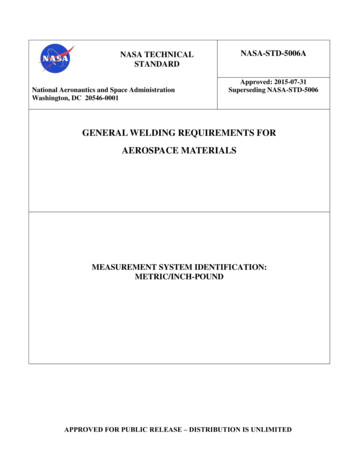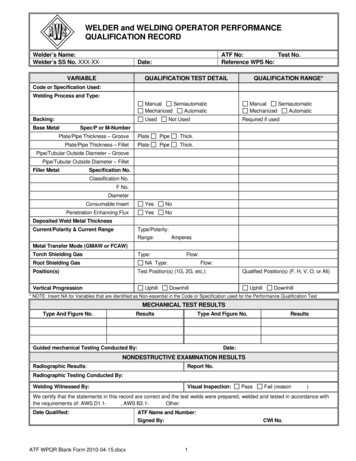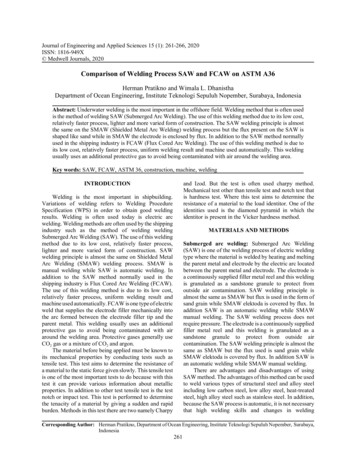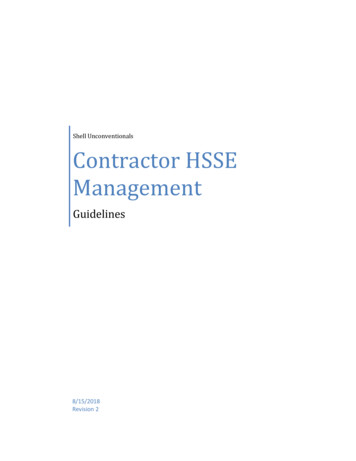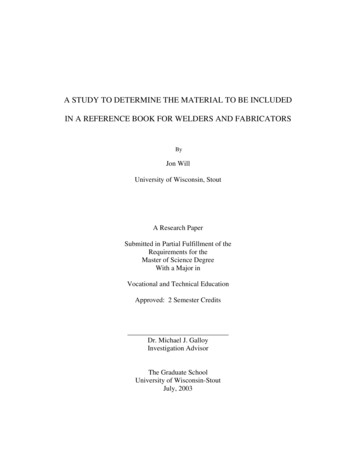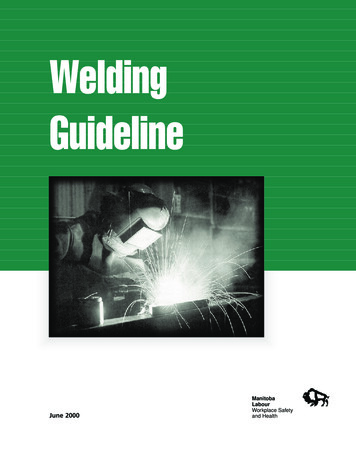
Transcription
WeldingGuidelineJune 2000ManitobaLabourWorkplace Safetyand Health
Table of ContentsSummary . . . . . . . . . . . . . . . . . . . . . . . . . . . . . . . . . . . . . . . . . . . 3What is Welding . . . . . . . . . . . . . . . . . . . . . . . . . . . . . . . . . . . . . . . . . . . . . . . . 4Electric Arc Welding . . . . . . . . . . . . . . . . . . . . . . . . . . . . . . . . . . . . . . . . . . . . . 5Three Basic Types of Electrodes . . . . . . . . . . . . . . . . . . . . . . . . . . . . . . . . . . . . . 6Gas Welding . . . . . . . . . . . . . . . . . . . . . . . . . . . . . . . . . . . . . . . . . . . . . . . . . . 6Common Types of Welding Processes . . . . . . . . . . . . . . . . . . . . . . . . . . . . . . . . 71) Electric Arc Welding . . . . . . . . . . . . . . . . . . . . . . . . . . . . . . . . . . . . . 72) Combustion Gas Welding . . . . . . . . . . . . . . . . . . . . . . . . . . . . . . . . 12Airborne Hazards from Welding Processes1) Fumes . . . . . . . . . . . . . . . . . . .2) Gases . . . . . . . . . . . . . . . . . . .3) Particulate Matter . . . . . . . . . .13131314Welding Fume Composition . . . . . . . . . . . . . . . . . . . . . . . . . . . . . . . . . . . . . . 15Primary Health Effects of Exposure . . . . . . . . . . . . . . . . . . . . . . . . . . . . . . . . . . 17Sampling Methodology and Allowable Guidelines . . . . . . . . . . . . . . . . . . . . . . 24a) Welding Fumes . . . . . . . . . . . . . . . . . . . . . . . . . . . . . . . . . . . . . . . . 24b) Welding Gases . . . . . . . . . . . . . . . . . . . . . . . . . . . . . . . . . . . . . . . . 24Basic Welding Control Measures . . . . . . . . . . . . . . . . . . . . . . . . . . . . . . . . . . . 261) Substitution . . . . . . . . . . . . . . . . . . . . . . . . . . . . . . . . . . . . . . . . . . 262) Ventilation . . . . . . . . . . . . . . . . . . . . . . . . . . . . . . . . . . . . . . . . . . . 26Personal Protective Equipment for Welders . . . . . . . . . . . . . . . . . . . . . . . . . . . . 36Special Welding Situations . . . . . . . . . . . . . . . . . . . . . . . . . . . . . . . . . . . . . . . 40Checklist . . . . . . . . . . . . . . . . . . . . . . . . . . . . . . . . . . . . . . . . . . . 43References and Additional Reading . . . . . . . . . . . . . . . . . . . . . . 49Welder’s Guide – 1
Figure 1 - Welding Circuit . . . . . . . . . . . . . . . . . . . . . . . . . . . . . . . . . . . . . . . . . . . . . . 5Figure 2 - Shielded Metal Arc Welding . . . . . . . . . . . . . . . . . . . . . . . . . . . . . . . . . . . . . 7Figure 3 - Gas Tungsten Arc Welding . . . . . . . . . . . . . . . . . . . . . . . . . . . . . . . . . . . . . . 8Figure 4 - Gas Metal Arc Welding . . . . . . . . . . . . . . . . . . . . . . . . . . . . . . . . . . . . . . . . . 9Figure 5 - Fluxed Cored Arc Welding . . . . . . . . . . . . . . . . . . . . . . . . . . . . . . . . . . . . . . 10Figure 6 - Submerged Arc Welding . . . . . . . . . . . . . . . . . . . . . . . . . . . . . . . . . . . . . . . 11Figure 7 - Resistance Welding . . . . . . . . . . . . . . . . . . . . . . . . . . . . . . . . . . . . . . . . . . . 11Figure 8 - Standing Workbench Design and Seated Workbench Designs . . . . . . . . . . . . 21Illustration VS-90-01 - Welding ventilation bench hood . . . . . . . . . . . . . . . . . 28Illustration VS-90-02 - Welding ventilation movable exhaust hoods . . . . . . . . 29Illustration VS-90-03 - Production Line Welding Booth . . . . . . . . . . . . . . . . . 30Illustration VS-90-10 - Torch Cutting Ventilation . . . . . . . . . . . . . . . . . . . . . . 31Illustration VS-90-20 - Robotic Application . . . . . . . . . . . . . . . . . . . . . . . . . . 33Figure 9 - Welding Gun Mounted on Exhaust Hood . . . . . . . . . . . . . . . . . . . . . . . 22 & 32Figure 10 - Portable Fume Extractor . . . . . . . . . . . . . . . . . . . . . . . . . . . . . . . . . . . . . . 34Figure 3.3 - Direction of Air Flow . . . . . . . . . . . . . . . . . . . . . . . . . . . . . . . . . . . . . . . . 34Figure 11 - Examples of Respiratory Protection for Welding . . . . . . . . . . . . . . . . . . . . . 37Table 1 - Minimum Respiratory Protection Recommendations for Welding Processes . . . 38Figure 12 - Welder’s Helmet . . . . . . . . . . . . . . . . . . . . . . . . . . . . . . . . . . . . . . . . . . . . 39Table 2 - Shade Numbers for Arc Processes . . . . . . . . . . . . . . . . . . . . . . . . . . . . . . . . . 41Table 3 - Shade Numbers for Cutting . . . . . . . . . . . . . . . . . . . . . . . . . . . . . . . . . . . . . 42AcknowledgementsCover Photo3M Canada CompanyIllustrations: VS-90-01, VS-90-02, VS-90-03, VS-90-10 and VS-90-20 From American Conferenceof Governmental Industrial Hygienists (ACGIH)Industrial Ventilation: A Manual of Recommended Practice, 21st Ed. Copyright 1992.Cincinnati, OH. Reprinted with permissionFigures 1 to 12 and Tables 1 to 3From Welders Health and Safety Guide with the permission of the Canadian Centre forOccupational Health and Safety (CCOHS), 250 Main Street East, Hamilton, Ontario L8N 1H6Tel.: (905) 572-4400; Toll free: 1-800-263-8466; Fax: (905) 572-4500; E-mail: Inquiries@ccohs.caVisit CCOHS’ Website to see a complete list of publications and other information services,www.ccohs.ca2 – Welder’s Guide
SUMMARYThe intent of this WELDING GUIDELINE is to serve as a resource for employers and workers tosafely perform welding activities. The guideline will provide information on: the types of welding processes the hazards (noise, smoke characteristics, metal contents, ultraviolet light, ozone, carbonmonoxide & other gases) health effects of exposure current allowable guidelines ventilation guidelines PPE requirements special welding situations checklist referencesWelder’s Guide – 3
WHAT IS WELDING?The welding process joins metals together using pressure, heat, flame or electric arc. In thewelding process, a filler metal and the work piece are heated to form the weld using an electricarc or combustion gas. Arc welding is the most common form of welding. As the metal is heated,vaporization occurs and a fine metal fume condenses usually with visible smoke. Inhalation is theprimary route of exposure for the welder.Ninety per cent of the welding fumes come from the melting of the consumable electrode (rod) orwire. In the weld, the filler metal used is similar to the metal being welded. Some electrodes arecoated and some wire consists of a metal sheath filled with a flux (flux-cored wire). The coatingand flux contribute towards the chemical composition of the airborne fumes generated. Fumecomposition is a mix of the base metal, flux and consumable wire or electrode used in the weld.Refer to the Material Safety Data Sheets (MSDS’s) provided by the supplier.4 – Welder’s Guide
ELECTRIC ARC WELDINGWELDING CIRCUIT FIG. 1Figure 1CCOHS. 1999. Welders’ Health and Safety Guide. Hamilton, Canadian Centre for Occupational Health andSafety, p.38. (Published with permission)A cable to the welding gun connects the welding machine. An electrical current flows through thecable and the electrode/wire creating an arc, which then passes the current to the work piecebeing welded. The closed loop in the current system allows the current to be returned to thepower supply via the work-return-lead.Welder’s Guide – 5
THREE BASIC TYPES OF ELECTRODES1) SOLID ELECTRODES produce less fumes, compared with flux-cored wire or coated electrodes.Fume production is directly related to the amount of consumed electrode. Electrodes areconsumable (composed of steel, copper, aluminum, various alloys and other metals) or nonconsumable (primarily tungsten).2) COVERED & COATED ELECTRODES are the largest group of electrodes used in welding. Thecovering provides the flux for the weld. Major metals from the coatings include fluoride,nickel, iron, chromium, manganese, copper and molybdenum. Fluoride tends to be the majorcomponent ranging from 10–20% of the fume composition.3) BARE RODS OR WIRE are immersed in the flux material and fume generation is greatlyreduced. Bare rods or wire are typically composed of copper alloys, steel, nickel alloys, nickelor chromium-steel alloys.GAS WELDINGGases Used in Welding & Cutting Processes shielding gases, e.g. argon, carbon dioxide, helium fuel gases, e.g. propane, acetylene, butane oxygen (used with fuel & shielding gases)6 – Welder’s Guide
COMMON TYPES OF WELDING PROCESSES1. ELECTRIC ARC WELDINGELECTRIC ARC WELDING: uses an electric arc (a continuous electrical discharge) to generate hightemperatures of 3,000º to 30,000ºC. The electric arc is maintained at the gap between the workpiece and the electrode. The arc is manipulated such that molten metal from the work piece andthe electrode or wire form a common puddle which then cools forming the weld.The various types of electric arc welding include:a) SHIELDED METAL ARC WELDING (SMAW) FIG. 2Figure 2CCOHS. 1999. Welders’ Health and Safety Guide. Hamilton, Canadian Centre for Occupational Health andSafety, p.16. (Published with permission)Shielded Metal Arc Welding (SMAW) is the most common type of welding used in maintenanceand repair work. SMAW is also referred to as manual, electrode or stick welding.In this welding process, an electric arc is drawn between the tip of an electrode and the metalbeing welded. The electrode has a metal core, which is covered with a flux or coating. In theconsumable electrode process, the electrode is used up as the work piece is welded.The flux shields metal ions in the arc from the atmosphere and ensures arc stability. As the fluxdecomposes, it produces airborne gases and a slag blanket is formed to protect the hot weldmetal from the atmosphere as it cools.SMAW is widely used in maintenance and repair applications on mild & stainless steel, aluminumand non-ferrous metals. SMAW has limited application in the workplace, since the welding muststop to replace the consumed electrode. SMAW is replaced in the welding industry with thecontinuous wire processes.Welder’s Guide – 7
b) GAS TUNGSTEN ARC WELDING (GTAW) FIG. 3Figure 3CCOHS. 1999. Welders’ Health and Safety Guide. Hamilton, Canadian Centre for Occupational Health andSafety, p.16. (Published with permission)Gas Tungsten Arc Welding (GTAW) is also referred to as TUNGSTEN INERT GAS (TIG) Welding.In GTAW, an electric arc is established between the work piece and the tungsten electrode. Incontrast to SMAW, this is a non-consumable electrode process. The arc is protected by a flowof a shielding gas, commonly argon (also helium or mixtures of these two gases), which displaceatmospheric gases from the weld zone. The arc can fuse two metals together without the use of afiller metal. A hand-held filler rod can be placed near the arc and melted to fill any gaps. GTAW iscommonly used to weld aluminum. It also has application to mild & stainless steel.Ultraviolet (UV) light from the electric arc is intense and ozone gas is produced. GTAW producesno slag and produces small amounts of fume. The tungsten electrodes contain small amounts ofthorium ( 4%), readily burning in air to thorium oxide. Thorium is a radioactive metal and posesan inhalation and ingestion hazard.8 – Welder’s Guide
c) GAS METAL ARC WELDING (GMAW) FIG. 4Figure 4CCOHS. 1999. Welders’ Health and Safety Guide. Hamilton, Canadian Centre for Occupational Health andSafety, p.20. (Published with permission)The Gas Metal Arc Welding (GMAW) process is referred to as “hard wire” or METAL INERT GAS(MIG). In this type of welding, a continuous solid wire is supplied through the welding gunfrom the wire feeder. Shielding is provided by an inert gas, commonly argon (also helium or a mixof these with carbon dioxide). There is no slag produced because no flux is used in this type ofwelding.GMAW is used throughout the industry primarily for welding mild steel, but also copper, nickel,stainless steel, magnesium and aluminum.Welder’s Guide – 9
d) FLUXED CORED ARC WELDING (FCAW) FIG. 5Figure 5CCOHS. 1999. Welders’ Health and Safety Guide. Hamilton, Canadian Centre for Occupational Health andSafety, p.19. (Published with permission)The Fluxed Cored Arc Welding (FCAW) process is also referred to as “fluxed cored”.In FCAW, a continuous solid wire is fed through the welding gun from a wire feeder. The wireconsists of a metal sheath filled with a flux. The flux helps to establish the arc, provides additivesto the weld, and produces a slag.In gas-shielded FCAW, the shield gas (mix of carbon dioxide & inert gas) is used to protect the arc.In self-shielded FCAW, the flux decomposes to produce the shielding gas and slag. FCAW is usedto weld mild and alloy steel and generates large amounts of fumes.e) PLASMA ARC WELDING (PAW) & PLASMA ARC CUTTING (PAC)The plasma processes use a non-consumable tungsten electrode and a shielding gas, similar toTIG welding. The plasma torch uses a constriction cup, which forces the arc out into a narrow jet.When the diameter of the constriction cup is reduced, a finer arc jet is produced which can beused for cutting or gouging applications.Arc cutting is the general process in which the cutting or removal of metals is completed bymelting with the heat of an arc between the base metal and the electrode. In plasma Arc Cutting(PAC), the metal is cut by melting a localized area with a constricted arc and removing the moltenmaterial with a hot high-velocity jet of ionized gas. PAC can be conducted under a water blanketon a water table, which traps noise, arc light, gases, and fumes.During the PAC and PAW processes, the arc jet released into the air produces ozone and nitrogenoxides, and high frequency noise (range 95 to 100dBA). These noise levels are in excess of thecurrent Manitoba noise standard of 90 dBA (Manitoba Regulation 227/94, W210). PAWgenerates low amounts of fumes compared with other processes. PAC generates higheramounts of fumes, noise and ozone levels than PAW except when cutting is done under awater blanket.10 – Welder’s Guide
f) SUBMERGED ARC WELDING FIG. 6Figure 6CCOHS. 1999. Welders’ Health and Safety Guide. Hamilton, Canadian Centre for Occupational Health andSafety, p.22. (Published with permission)In Submerged Arc Welding (SAW), the arc is buried under a granular flux bed. The flux trapsnoise, light, gases and fumes. SAW uses a consumable electrode. The tip of the electrode andthe welding zone are surrounded and shielded by the molten flux and layer of unused flux in thegranular state. No visible evidence of the passage of the current between the electrode and thework surface is evident. Fumes are generated, but in lesser quantities compared with otherwelding processes.g) RESISTANCE WELDING FIG. 7Figure 7CCOHS. 1999. Welders’ Health and Safety Guide. Hamilton, Canadian Centre for Occupational Health andSafety, p.23. (Published with permission)Welder’s Guide – 11
Resistance welding is also referred to as spot, flash or seam welding. The weld is produced bypressure applied at the electrode contact points and heat from the electric current. The electrodesare commonly copper or copper-beryllium alloy. No filler metal or flux is used.2. COMBUSTION GAS WELDINGGas welding uses the heat from the combustion of oxygen and one of the following gases:acetylene, propane, hydrogen and butane. In this welding process, the filler electrode is manuallyintroduced. It is used for repair work and light sheet metal. The flame temperature in combustiongas welding is lower than in electric arc and is considered less hazardous.12 – Welder’s Guide
AIRBORNE HAZARDS FROM WELDING PROCESSES1. FUMESFumes are very fine solid particulates formed when a metal is heated above its boiling point.Fumes are created by the condensation from the metal vapour state. Welding fume particles aregenerally less than 1 micron (u) in diameter, (one millionth of a meter – 1u). Welding fumeparticles penetrate into the alveoli region of the lung. All welding processes produce fumes, butthe quantity varies widely depending on the process.NOTE: Fumes may be present during welding whether a smoke plume is visible or not.Welding smoke is an example of visible fumes.The health hazard of fumes depends on: amount of fume produced presence of specific metals & gasesTwo basic mechanisms of fume generation: vaporization of the elements & oxides from the arc area (near the electrode tip) rapid condensation of the vapours to form solid particlesMajor sources of fume: electrode metal flux material coatings, residues, oils, rust inhibitors, solvent-based paints, primers on the base metala) Consumable electrode process: Here the electrode is consumed in the weld. Fumesgenerated originate from the electrode, electrode coating or fluxes. The base metal beingwelded contributes a small portion.b) Non-consumable electrode process: Here the amount of fumes generated is less, comparedwith the consumable electrode process. Fumes generated originate from the base metal beingwelded and the filler rod.2. GASESThe following gases are produced from the: decomposition of shielding gases & fluxes interaction of ultraviolet light or high temperatures with atmospheric gases shielding gasa) OZONE, due to the ionization of oxygen by ultraviolet lightb) CARBON MONOXIDE, from the ultraviolet effects on carbon dioxide in the shielding gasc) SHIELD GASES, such as helium, argon and carbon dioxided) FLUORIDE GASES and other thermal decomposition products of fluxes and electrode coatingse) FLAMMABLE GASES, such as acetyleneWelder’s Guide – 13
3. PARTICULATE MATTER originating from the grinding process required in some welding applications.SOME WELDING PROCESSES GENERATE MORE WELDING FUMES THAN OTHERSHIGHESTFlux Core Arc Welding (FCAW)Shielded Metal Arc Welding (SMAW)Gas Metal Arc Welding (MIG)LOWESTGasTungsten Arc Welding (TIG) BE AWARE that a lower fume concentration may result in higher concentrations of ozone& nitrogen oxide gases. plasma arc cutting (PAC) produce less fumes, due to the finer cuts which remove less basemetal materialFUME GENERATION RATE CAN BE ALTERED BY:a) Voltage – as the voltage increases, more fumes are generatedb) Arc Length – as the arc length increases, more fumes are generatedc) Current – as the current increases, more fumes are generated the exception is GMAW of aluminum where higher currents generate less airborne fumed) Electrode Diameter – a smaller diameter electrode which results in more fumes generatede) Electrode Polarity – 30% more fumes are generated by welding DC positive, compared withDC negative or ACf) Shielding Gas The composition of the shielding gas can significantly affect the fumes generated. An argonand carbon dioxide mix reduces fume generation up to 25%, compared with using onlycarbon dioxide.g) Composition of the base metal, fluxes and fillers (refer to MSDS’s) A system has been developed by the American Welding Society to classify all consumablewelding electrodes and rods. Every manufactured welding rod and electrode is referencedback to an MSDS. Encourage all welders to refer to the information contained on the MSDS.h) Effectiveness of the existing ventilation system (general dilution vs local)i)Welder’s work practices and years of experience when the distance between the work piece & electrode tip is increased, more fumes aregenerated (more vaporized metal is exposed to the environment)j)Wire feed speed: as the feed speed increases, more metal is used and fume generationincreasesk) Humidity: in humid environments, the amount of fume generated increases due toabsorption by fluxesl)Position of weld: a flat horizontal position produces less fume, compared with an overheador vertical position14 – Welder’s Guide
WELDING FUME COMPOSITIONWelding fumes are a complex mixture of metallic oxides, fluorides and silicates. A summary of thecommon gases & metals for the most frequently encountered welding processes in Manitobawelding workplaces are:1. SHIELDED METAL ARC WELDING (SMAW)a) Mild steel welding (MIG)Welding fumes generated from mild steel welding were found to contain primarily iron andmanganese. In addition, small amounts (less than the ACGIH current guidelines) of aluminum,calcium, copper, magnesium, sodium and zinc were determined. Trace amounts of chromium,potassium, nickel and lead were also determined.METALS:iron oxide & manganeseWelding mild steel generates more fumes compared with stainless steel or nickel alloys, but haslower concentrations of chromium and nickel.GASES:ozone & nitrogen oxidesb) Stainless steelMETALS:nickel, chromium & manganeseGASES:fluoridesWelding fumes from stainless steels have higher amounts of chromium and/or nickel, but less ironcompared with MIG mild steel welding.2. GAS METAL ARC WELDING (MIG)MIG for STAINLESS STEELMETALS:nickel, chromium & manganeseGASES:ozone, nitrogen oxides3. GAS TUNGSTEN ARC WELDING (TIG)TIG for ALUMINUMMETALS:aluminum oxideGASES:ozone & nitrogen oxidesAluminum vaporizes more readily than mild steel, thereby producing more fumes.Welder’s Guide – 15
4. SUBMERGED ARC WELDING (SAW)SAW for MILD STEELMETALS:metal fumes (depends on composition of work piece being welded)GASES:fluoridesSubmerged arc welding is used mostly for welding low alloy steel and carbon. Fume generation isreduced, compared with other welding processes. Fluorides generated pose a significant hazard.5. PLASMA ARC WELDINGInvolves various base metalsMETALS:metal fumes (depends on composition of work piece being welded)GASES:ozone & nitrogen oxidesNOISE:Excessive noise levels (levels 90dBA) pose a significant hazard (at 90dBA mandatory hearing protection is required as per Manitoba Regulation 227/94,W210)6. PLASMA ARC CUTTINGPlasma arc cutting produces a higher volume of fumes & gases, compared with plasmaarc welding.METALS:metal fumes (depends on composition of work piece being welded)GASES:high levels of ozone & nitrogen oxidesNOISE:excessive noise levels (levels 90 dBA) pose a significant hazardOTHER:produces heat, metal sparks & hot spattersNOTE: Underwater plasma cutting provides greater noise reduction, compared with thewater shroud, because the entire working end of the torch & the arc are completelysubmerged in water.16 – Welder’s Guide
PRIMARY HEALTH EFFECTS OF EXPOSURE1. The primary short-term effects are: metal fume feverwelder’s flash (ultraviolet radiation)2. The long-term effects are less well-understood.1. METAL FUME FEVER: metal fume fever occurs after exposure to high concentrations of magnesium (Mg), copper(Cu) & zinc (Zn) this acute condition occurs when a freshly formed fume is inhaled symptoms develop: 8 – 12 hours after exposure & tend to subside after 24 – 48 hours symptoms include: fever, headache, cough, chest pains, chills, muscle aches & metallic tasteZinc is the major component of the galvanized coatings used on steel and is the more frequentlyencountered metal.SOME IDENTIFIED HEALTH EFFECTS from metal exposure:a) Siderosis is a benign lung condition due to exposure from iron oxides.b) Chronic exposure to Manganese results in central nervous system problems similar toParkinson’s disease.c) Cadmium affects respiratory system (chest pain & difficulty breathing). The chronic effectincludes kidney damage – Biological Exposure Index (BEI) 5ug/g creatinine.d) Chromium has been associated with skin ulceration, perforated nasal septum & an increasedrisk of lung cancer.e) Fluorides: acute effects – eye, nose & throat irritationLong-term effects – pulmonary edemaf) Lead: blood lead level – 30 ug/100 ml (ACGIH BEI 1997 - 98).Chronic effects – anemia, fatigue, abdominal pain & kidney damageg) Nickel: acute effects – eye, nose, throat & skin irritationLong term effects – increased risk of nasal & lung cancerh) Lung cancer: a 40% higher than normal lung cancer rate among welders has been reportedin the literature. Some of these reports are from studies conducted 10 years ago whenwelding processes had no (or limited) engineering controls in the workplace.Welder’s Guide – 17
2. RADIATIONWelding arcs emit intense ultraviolet (UV) radiation. UV radiation in the welding arc will tan andburn the skin, similar to UV radiation from sunlight. Long-term exposure to UV radiation cancause skin cancer.UV radiation to the eye injures the cornea and mucous membrane and is referred to as “welder’sflash or arc eye or arc flash”. The medical term for this condition is photokeratitis andphotoconjunctivitis.WELDER’S FLASH: The cornea of the eye becomes inflamed when exposed to ultraviolet(UV) light.Symptoms: sensation of “sand in the eyes”ranging from a feeling of pressure in the eyes to intense paintearing & reddening of the eye membranesphotophobia: inability to look at a light sourceSymptoms develop: 4-6 hours after exposure & tend to subside after 24 hoursUV EXPOSURE IS:HIGHESTPlasma Arc Welding (PAW)Gas Metal Arc Welding (MIG)Shielded Metal Arc Welding (SMAW)LOWESTGas Tungsten Arc Welding (TIG)Visible and infrared light are also emitted and present a hazard to the welder and other nonwelders. The associated hazards with these two forms of radiation are considered to be lesshazardous to the eye. Visible light, if intense, may cause eye fatigue and infrared light may be feltas heat.3. GASESa) OZONE (O3) – due to ionization of oxygen (O2) by the ultraviolet light (UV) from arc welding.UV O2 O3Ozone is classified as a pulmonary irritation & can cause pulmonary edema.b) CARBON MONOXIDE (CO) – from the ultraviolet effects on carbon dioxide (CO2) in theshielding gas.UV CO2 COCarbon monoxide is classified as a chemical asphyxiant resulting in anemic hypoxia.Hemoglobin has a 220 times greater affinity for carbon monoxide, compared with oxygen,with the resultant carboxyhemoglobin complex formation in the blood.18 – Welder’s Guide
Carbon monoxide is an odourless and colourless gas. Acute symptoms include dizziness,headache & mental confusion. The airborne concentration of carbon monoxide generatedfrom the welding process was determined to be 5 ppm (measured at source) as per theWSH Branch welding proactive study 1998-99.Note: A poorly adjusted flame will result in higher amounts of carbon monoxide.c) CARBON DIOXIDE – from the decomposition of fluxesCarbon dioxide is classified as a simple asphyxiant. It displaces oxygen, reducing the amountof oxygen available in the air. Oxygen depletion may cause dizziness, disorientation,inattention, unconsciousness or even death if the level of oxygen drops too low. The minimumacceptable oxygen content in the air is 19.5%.d) NITROGEN OXIDES are formed from the heating of atmospheric oxygen & nitrogen (in thepresence of ultraviolet light). The oxide usually consists of nitrogen dioxide (NO2) and nitricoxide (NO). NO2 is the predominant oxide present in the fume. NO2 is irritating to the eyes,nose & throat at low concentrations (10-20 ppm) and at higher concentrations results inpulmonary edema.e) HYDROGEN CHLORIDE & PHOSGENE are produced by the reaction between ultraviolet lightand vapours from chlorinated hydrocarbon de-greasing solvents.Both of these gases irritate and can damage the respiratory system.4. LUNG IRRITATION/INJURY/CANCER: lung, nose & throat irritation, bronchitis, emphysema & asthma welders suffer a greater incidence of bronchitis, compared with the general population 40% increase of lung cancer reported among welders, compared with the generalpopulation most welders also tend to be smokers & in many Manitoba workplaces welders wereallowed to smoke on the shop floor5. NOISE: noise originating from the metal fabrication processes (e.g. metal to metal impacts,materials handling, metal working, grinding/drilling)Noise levels in Manitoba welding workplaces determined from the WSH Branch welding proactivestudy 1998-99 were found to be: 80dBA in shops that were continuously welding & also in the smaller shops that werespot welding ( 80 dBA requires the implementation of a Hearing Conservation Program) most welding shops were 90 dBA requiring mandatory hearing protectionSome methods of noise control in the workplace include: administrative controls: e.g. relocate welders away from noisy areas to reduce excessivenoise levelsWelder’s Guide – 19
engineering controls: replace noisy operations with quieter equipment, quieter processes orquieter materials reduce the driving force in mechanical equipment: decrease speed, maintain dynamicbalance, provide vibration isolation and increase the duration of impact while reducing theforce reduce the response of vibrating surface increase sound absorption use of equipment noise enclosures use of personnel noise enclosures use of some form of shield(s) or barrier(s)6. ERGONOMIC: REPETITIVE STRAIN INJURIESThe welding process places physical demands on the wrist, elbows, arms, shoulders & neck of thewelder, due to the awkward postures and forceful exertions required by the job. Musculoskeletalinjuries are common among welders, with female welders being placed at additional risk (often)due to poor design of equipment. The following ergonomic factors are prevalent in the weldingprocess:POSTURE equipment design – welder must adjust his/her body to make the tools work product design – welder must adopt to the product they are working on - low back pain isalso common among welders due to the nature of having to bend over the work piecebeing welded workbench design (seated or standing) & the use of positioning aids to accommodate workposture are provided in Fig. 820 – Welder’s Guide
Figure 8USE positioning aids to accommodate work posture.Welder’s Guide – 21
FORCE grip size (affects how hard you need to grip the tool) tool weight: the introduction of the smokeless-gun (Fig. 9) which has a fume extractionnozzle that covers the welding gun capturing the welding smoke – the disadvantage of thesmokeless gun is the additional weight, placing an additional strai
Shielded Metal Arc Welding (SMAW) is the most common type of welding used in maintenance and repair work. SMAW is also referred to as manual, electrode or stick welding. In this welding process, an electric arc is drawn between the tip of an electrode and the metal being welded. The electrode



